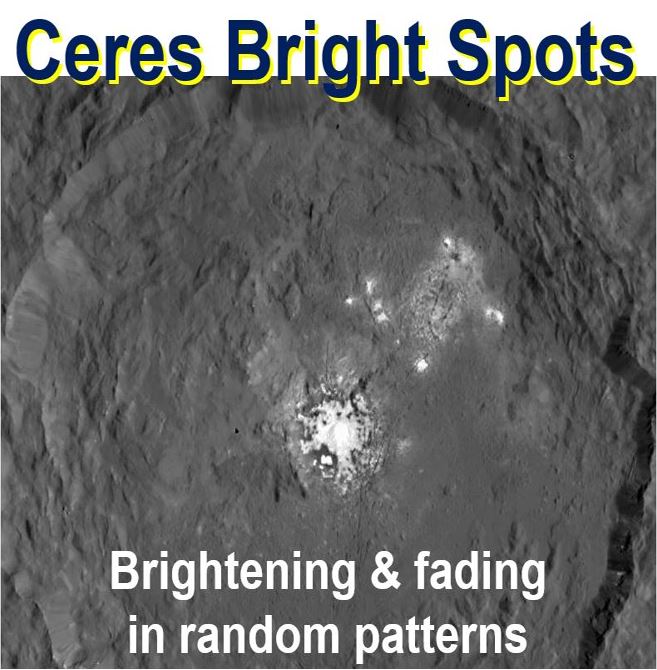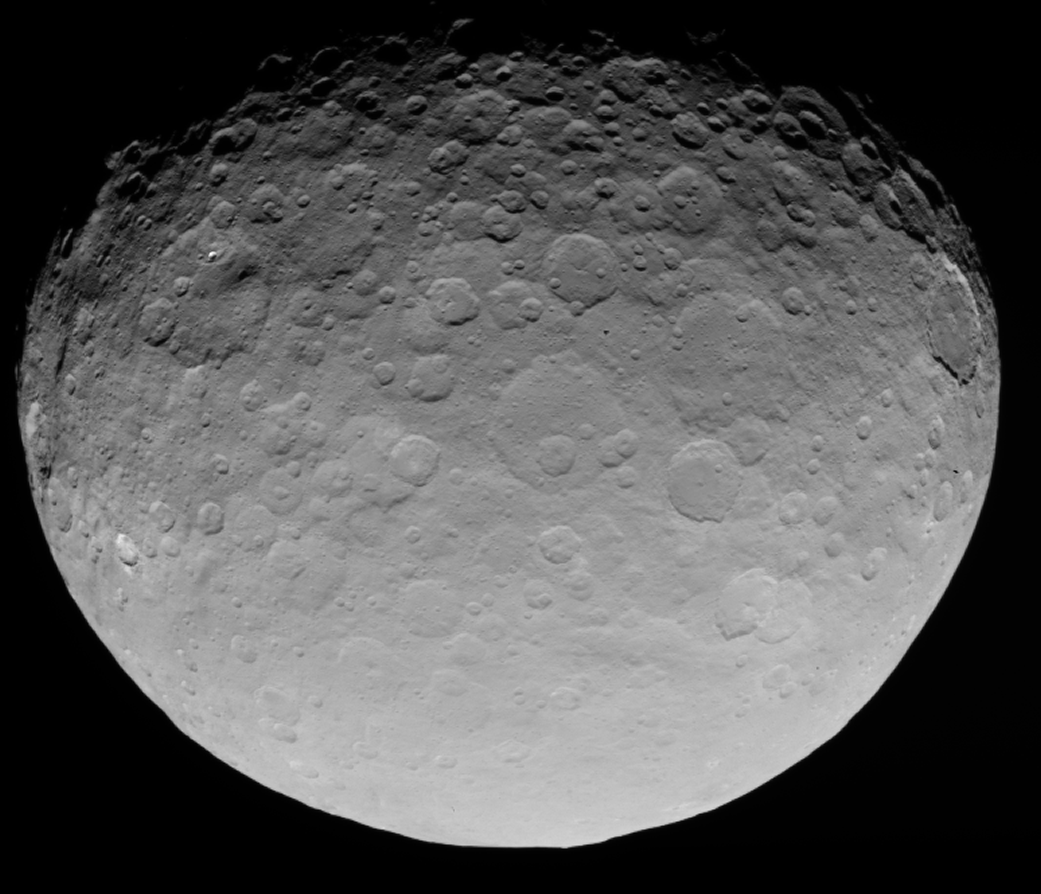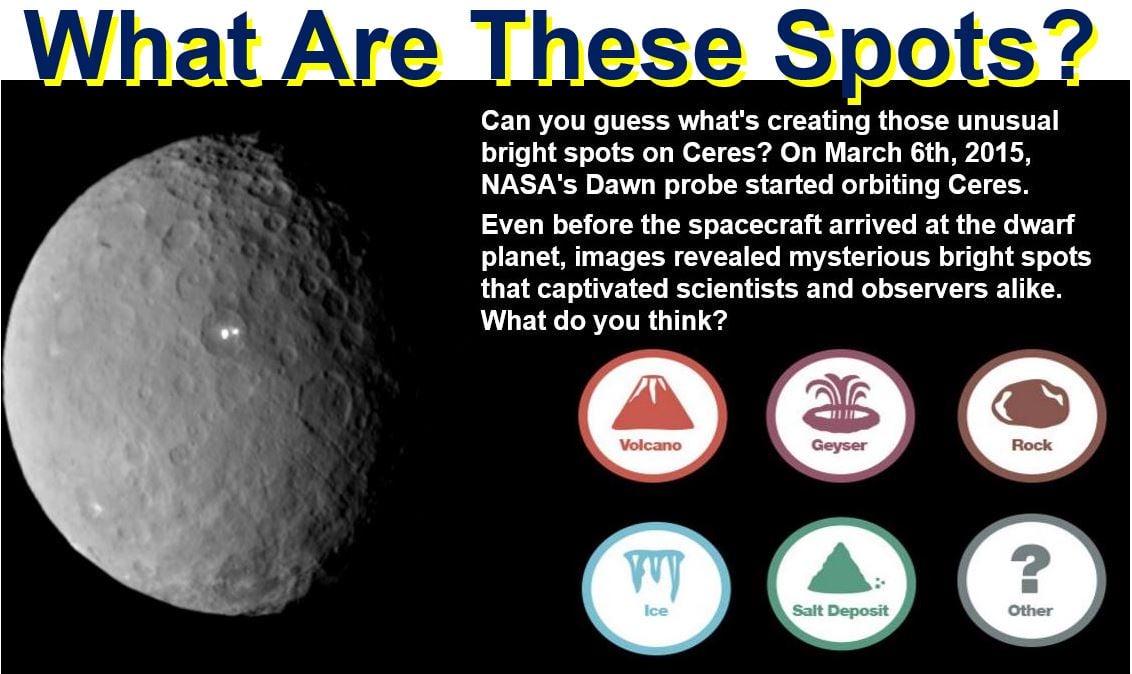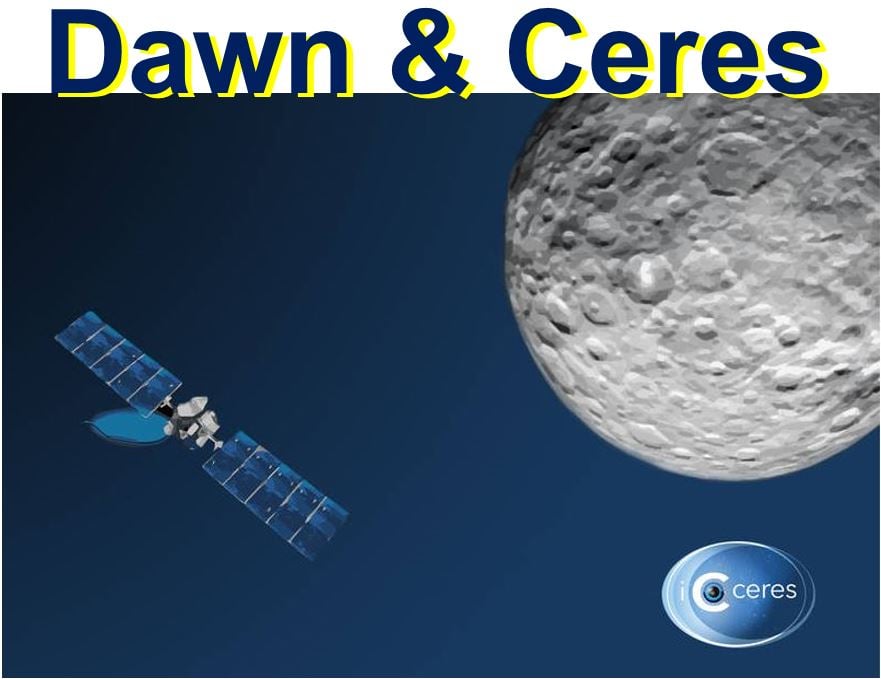The bright spots at Ceres brighten and fade mysteriously in random patterns, apparently throughout the day and night, say stunned scientists who say they have no logical explanation for the phenomenon. Ceres, a dwarf planet, is the biggest object in the asteroid belt whose orbit around the Sun is between that of Mars and Jupiter.
This newly observed behaviour of Ceres’ bright spots has been reported by a team of scientists from Chile, Italy and Germany in the scientific journal Monthly Notices Letters of the Royal Astronomical Society (citation below).
For more than a year, the enigmatic bright spots on the surface of Ceres have both fascinated and puzzled astronomers and members of the public. Scientists have suggested they might be some type of ice or salt deposits, while scores of lay people across the world are convinced they are made by intelligent aliens.
 Why do the Ceres bright spots brighten and fade in random patterns? It does not make any scientific sense. The spots in this image are in the Occator crater. (Image: jpl.nasa.gov)
Why do the Ceres bright spots brighten and fade in random patterns? It does not make any scientific sense. The spots in this image are in the Occator crater. (Image: jpl.nasa.gov)
According to the European Southern Observatory, recent observations made using the Harps spectrograph at the European Southern Observatory’s La Silla Observatory in Chile, by scientists from INAF-Trieste Astronomical Observatory, found that these bright spots do not follow scientifically explainable glow-and-fade patterns.
Random brightening and fading
They appear to glow and then fade in random patterns during the day, not at all linked to their positions and angle of sunlight.
The brightest and largest spots lie inside the crater Occator. Their presence suggest that Ceres may be considerably more active than most of its neighbouring celestial bodies.
Scientists had initially noticed that the lights change as Ceres rotates, and brighten during the day, suggesting that the spots contain volatile material that evaporates when hit by sunlight.
However, it now appears that some of the glowing and fading is totally at random and not related to Ceres’ rotation and the amount of sunlight that hits the areas where the spots are located.
 As you can see in this NASA animation, there are bright spots scattered all over Ceres. (Animation: nasa.gov)
As you can see in this NASA animation, there are bright spots scattered all over Ceres. (Animation: nasa.gov)
Ceres, which completes one rotation every nine hours, was observed with Harps for two whole nights in July and August last year.
Scientists had expected to see a gradual brightening and fading of the spots as the dwarf planet rotated, and were surprised to find random changes which had nothing to do with its day-to-night-to-day cycle.
Surprised by night-to-night patterns
Study co-author, Antonino Lanza, who works at the INAF-Catania Astrophysical Observatory, said:
“The result was a surprise. We did find the expected changes to the spectrum from the rotation of Ceres, but with considerable other variations from night to night.”
When the spots within the Occator crater were on the bright side – the side illuminated by sunlight – they formed plumes that reflected the sunlight very effectively.
When the plumes evaporated, which they did rapidly, they lost reflectivity and produced the observed changes.
However, they noticed that this effect changed from night-to-night, resulting in additional random patterns, both on long and shorter time scales.
 NASA is inviting members of the public from across the world to guess what those bright spots on Ceres are. (Image: jpl.nasa.gov)
NASA is inviting members of the public from across the world to guess what those bright spots on Ceres are. (Image: jpl.nasa.gov)
Ceres likely different from neighbours
The scientists said they need to have their interpretation confirmed. If it is, it would mean that Ceres is probably very different to Vesta and the other objects in the asteroid belt.
This news has been greeted with new suggestions in social media sites across the world, most of them fanciful and unlikely, from the usual aliens theories to gateways to other parallel universes.
The scientists in this study believe the changes are probably due to the presence of volatile substances that evaporate in the presence of solar radiation.
We know there is abundant water in Ceres. Nobody can determine whether water is in any way related to the presence of the bright spots or their brightening-fading patterns.
 An artist’s impression of NASA’s probe ‘Dawn’ approaching the dwarf planet Ceres. This small celestial object has captivated the scientific community and lay people with its mysterious bright spots. (Image: nasa.gov)
An artist’s impression of NASA’s probe ‘Dawn’ approaching the dwarf planet Ceres. This small celestial object has captivated the scientific community and lay people with its mysterious bright spots. (Image: nasa.gov)
Lead author, Paolo Molaro, who also works at the Observaory, said:
“As soon as the Dawn spacecraft revealed the mysterious bright spots on the surface of Ceres, I immediately thought of the possible measurable effects from Earth.”
“As Ceres rotates the spots approach the Earth and then recede again, which affects the spectrum of the reflected sunlight arriving at Earth.”
Dawn is a NASA space probe that was launched in 2007 to study two of the three known protoplanets within the asteroid belt – Ceres and Vesta. It is currently in orbit around Ceres. It will continue studying the dwarf planet and the behaviour of the mysterious bright spots.
Citation: “Daily variability of Ceres’ albedo detected by means of radial velocities changes of the reflected sunlight,” P. Molaro, A. F. Lanza, L. Monaco, F. Tosi, G. Lo Curto, M. Fulle and L. Pasquini. Monthly Notices Letters of the Royal Astronomical Society. 1 May 2016. DOI: 10.1093/mnrasl/slw017.
Video – Motions of bright spots on Ceres
This European Southern Observatory video is an artist’s impression based on a detailed map of the surface compiled from images taken from the Dawn spacecraft in orbit around Ceres. It shows the bright spots in the crater Occator and elsewhere.
